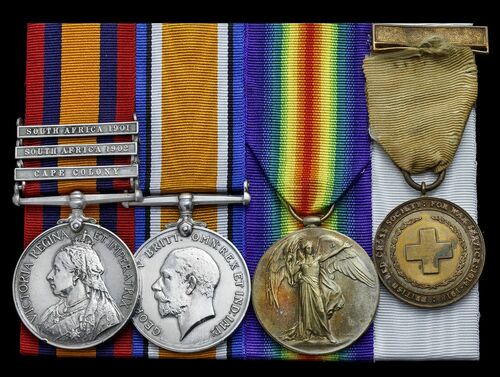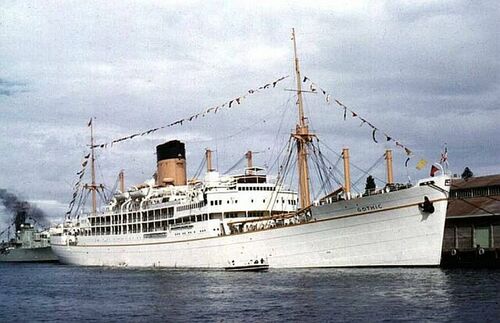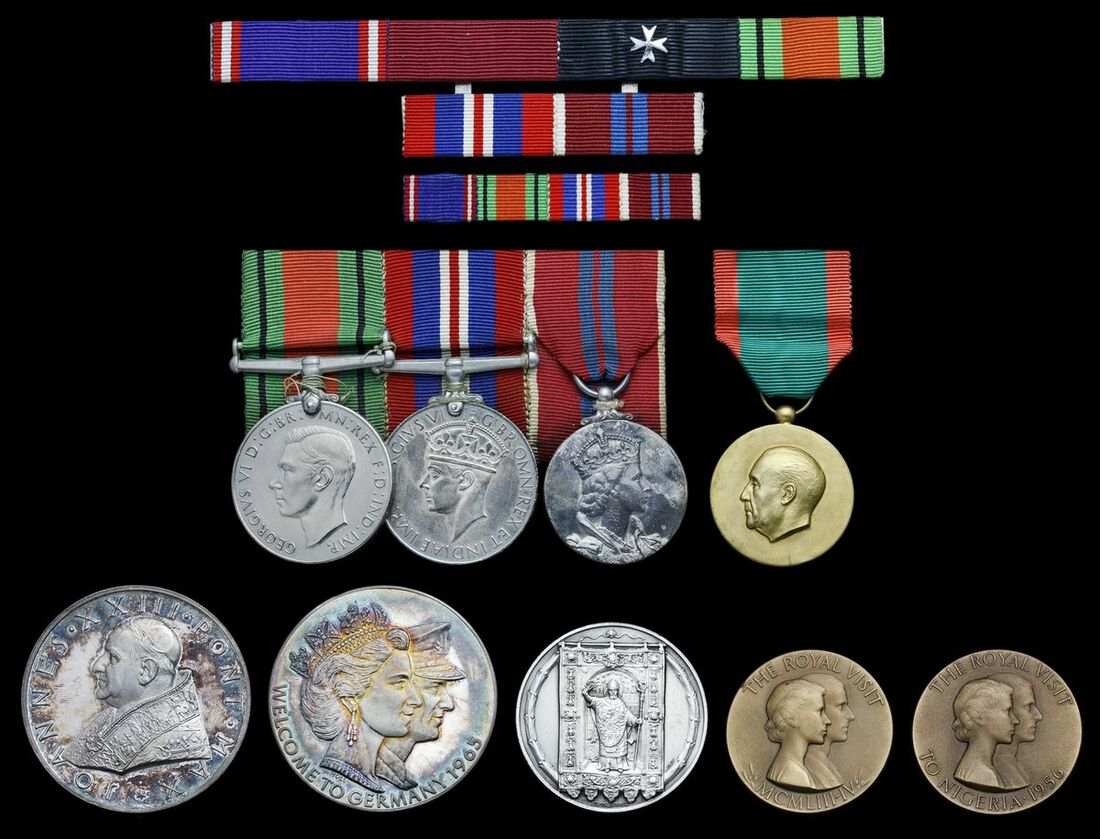Auction: 24002 - Orders, Decorations and Medals
Lot: 106
A family collection to father and son
Four: Captain D. S. Steele-Perkins, Cape Town Highlanders, later Royal Army Medical Corps
Queen's South Africa 1899-1902, 3 clasps, Cape Colony, South Africa 1902, South Africa 1901, (Lieut: D. Steele-Perkins. Cape Town Hdrs), the clasps mounted in that order; British War and Victory Medals (Capt. D. S. Steele-Perkins.); British Red Cross Society War Service medal, unnamed as issued, edge bruise to first, overall very fine (4)
The remarkable campaign group of three attributed to Surgeon Vice-Admiral Sir D. D, Steele-Perkins, Royal Navy, who was attending on the then Princess Elizabeth and Prince Philip during the Royal Tour 1952 and was present when the news of George VI's death arrived and following a long and distinguished career became Medical Director of the Navy
Defence and War Medals 1939-45; Coronation 1952, mounted as worn, sold together with two papal commemorative medals, four medals commemorating post war Royal visits, as well as a riband bar, good very fine (3)
Duncombe Steele Steele-Perkins was born at Exeter, Devon on 3 September 1882, the son of Alfred and Mary Steele-Perkins. Still a young man on the outbreak of the Second Anglo-Boer War Steele-Perkins reached his majority in 1900 and was immediately commissioned Lieutenant with the Cape Town Highlanders, serving though 1901-1902. Returning to Britain after the war he studied at Guy's Hospital before attending the Royal College of Physicians and Surgeons of Glasgow.
Becoming a Licentiate of the Royal Faculty of Physicians and Surgeons in 1905 he became Medical Officer of Health for his local Urban District Council of Honiton, Devon. Moving to Fuidge House, Honiton, Devon he was living there on the outbreak of the Great War. As the war progressed Steele-Perkins joined the Royal Army Medical Corps with the rank of Lieutenant on 7 February 1916, later being promoted Captain.
Returning to Devon after the war he served as Medical and Public Vaccinations Officer for the 8th & 10th Districts. Working at the Honiton Hospital he was also the Medical Officer for Health for the Honiton Rural District, a role he was performing in 1957. Steele-Perkins died at Honiton on 31 March 1958; sold together with copied medal rolls and London Gazette extract.
[K.C.B.] London Gazette 1 January 1966.
[K.C.V.O.] London Gazette 13 June 1964.
Derek Duncombe Steele-Perkins was born at Honiton, Devon on 19 June 1908, the son of Duncombe and Sybil Steele-Perkins. Educated at Allhallows School, Rousdon he trained at the Royal College of Surgeons in Edinburgh where he represented his university at Athletics, also wrestling and playing Rugby for the county. Becoming Licentiate of the Royal Faculty of Physicians and Surgeons in 1930 he saw appointments as house surgeon at Gloucester Royal Infirmary and the Hammersmith Hospital. Joining the Royal Navy in 1932 he was commissioned Surgeon Lieutenant on 8 August 1933 at the Royal Naval Hospital Haslar.
His first ship was the river patrol boat Mantis on the China Station in 1934, this posting proved a mixed blessing as he missed out on a trail for the England XV as a result. Returning from China in 1936 he joined the Gunships stationed off Spain ensuring the lives of British citizens caught up in the Spanish Civil War. After this stop he joined Ganges the boy's training establishment at Shotley, during this time he married Joan Boddan of Birkdale, Lancashire.
Joining Vindictive in 1938 he was promoted Surgeon Lieutenant-Commander that same year and joined the Royal Naval Hospital at Chatham where he served for most of the war. Posted to Sydney in 1944 Steele-Perkins qualified with the Royal Australasian College of Surgeons along with a promotion to Surgeon-Commander.
Posted to Malta as the senior surgical specialist at the Royal Naval Hospital, Bighi he was to serve there for four years until he joined the Royal Yacht Gothic in 1951 as surgeon to the then Princess Elizabeth. During this time he saw a great deal of service with the many Royal Tours undertaken by the future Queen and Duke of Edinburgh including the famous visit to Ethiopia where she received the news of her father's death. Returning to Britain for the coronation is listed upon the roll as being 'member of Medical Personnel on duty at the Coronation Service'. Later he was posted away from the Royal Yacht but did attend upon the Queen on several further Royal Tours from then until the end of his career.
Promoted Surgeon Captain while stationed at Chatham in 1956 Steele-Perkins returned to Bighi as Senior Surgical Specialist before being appointed Medical Officer in Charge at Haslar in 1961 as well as the Queen's Honorary Surgeon. A further step up to Medical Officer to the Commander-in-Chief, Portsmouth between 1962-63 saw him appointed Surgeon Rear-Admiral in that latter year. It was with this rank that Steele-Perkins received his final appointment as Medical Director of the Navy in 1963.
This role saw him facing down the problems of the cold war combined with constant budget constraints and attempted cuts. It may well be considered a testament to his strength of character that the Royal Naval Medical Service survived, he was also a major adversary to attempts to amalgamate the three armed forces. Even during his final years of service Steele-Perkins attended a number of Royal tours and received over the course of his career a large number of awards. Notably he was Commander of the Order of St Olvav, Commander of the Order of Merit of the Federal Republic of Germany, Commander of the Order of the Two Niles and Knight of the Order of St. Benedict of Avis.
After retirement in 1966 he was chairman of his local R.N.L.I. committee as well as the Red Cross committee. Steele-Perkins died at Sailsbury, Wiltshire on 9 December 1994 being survived by three daughters and a nephew who was himself a Surgeon Captain; sold together with copied research including census data, medal rolls, copied obituary and Who Was Who entry as well as Seedie's Roll and coronation medal 1953 roll.
Subject to 20% VAT on Buyer’s Premium. For more information please view Terms and Conditions for Buyers.
Sold for
£650
Starting price
£400









